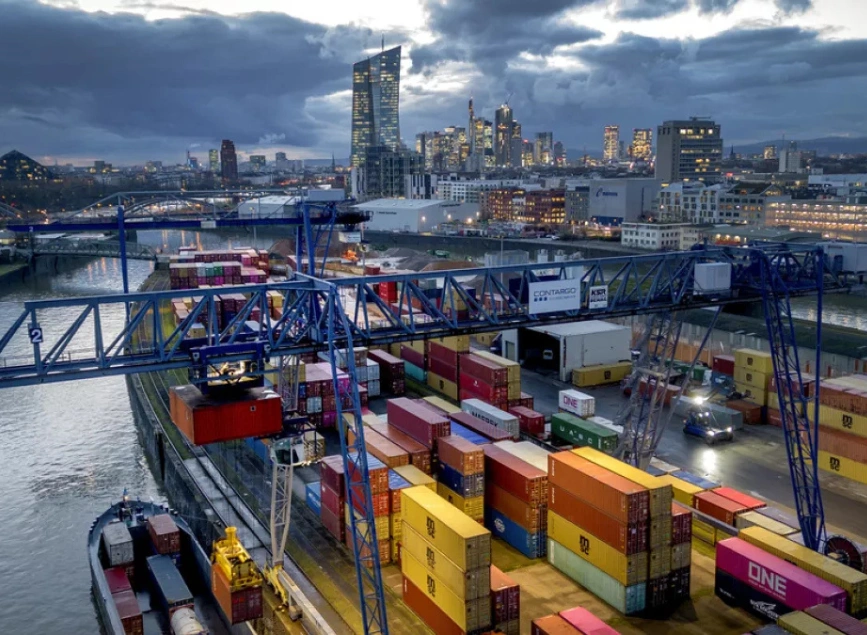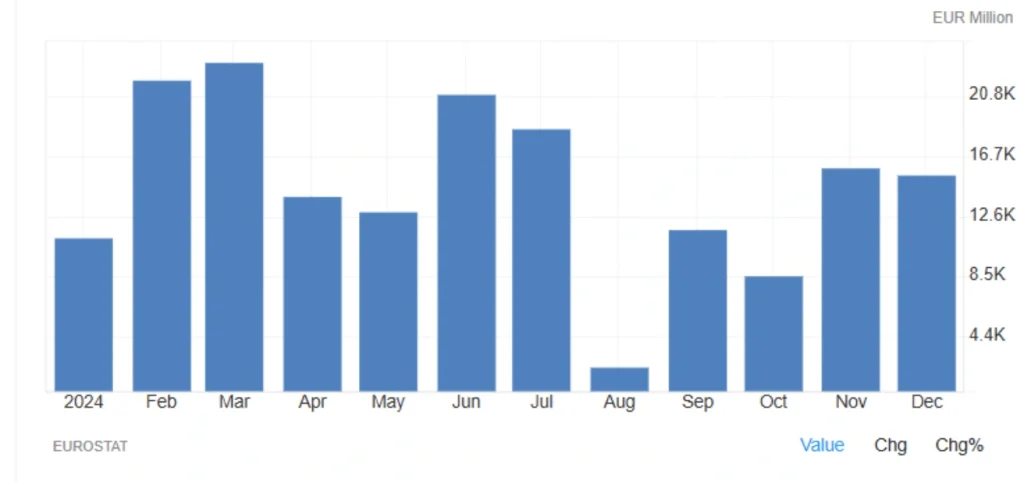
Eurozone Trade Surplus Shrinks in December 2024
The Eurozone’s trade surplus declined in December 2024, reflecting shifts in global trade dynamics. While the surplus remains strong, rising imports and changes in key sectors are reshaping the region’s economic landscape.
Eurozone Trade Surplus: A Mixed Picture
Slight Decline but Stronger Than Expected
The Eurozone’s trade surplus fell to 15.5 billion euros in December 2024, down from 16.4 billion euros a year earlier. Despite this decline, the figure was still higher than market forecasts of 14.4 billion euros, indicating resilience in the region’s trade balance.
Exports and Imports on the Rise
Exports grew by 3.1 percent, reaching 226.5 billion euros, while imports increased by 3.8 percent, totaling 211 billion euros. Across the entire European Union, the trade surplus rose to 16.3 billion euros, slightly higher than the 16.1 billion euros recorded in December 2023.
What’s Driving EU Trade Trends
Surge in Import Demand
Imports across the EU increased by 3.9 percent, largely due to higher demand in key sectors. Machinery and vehicles rose by 3.5 percent, chemical product imports climbed 0.8 percent, and food and beverage imports surged 20.5 percent.
Meanwhile, energy imports fell by 8.9 percent, highlighting the region’s efforts to reduce dependency on external energy sources.
Export Growth in Key Industries
EU exports expanded by 3.7 percent, driven by an increase of 14.3 percent in chemical product sales and a 3.6 percent rise in manufactured goods.
However, not all sectors saw gains. Energy exports declined by 10.8 percent, while machinery and vehicle exports dropped 1.1 percent, signaling potential shifts in demand for European industrial products.
A Stronger Annual Trade Surplus
Despite the slight decline in December, the Eurozone recorded a total trade surplus of 150.1 billion euros for 2024, a dramatic improvement from 34.4 billion euros in 2023. This reflects a broader trend of economic stabilization and increased competitiveness in global markets.

Why These Trade Changes Matter
Growing Demand for European Goods
The rise in exports, particularly in chemicals and manufactured goods, suggests that global demand for high-value European products remains strong. This is a positive sign for industrial production and job creation within the region.
Reduced Energy Imports and Economic Resilience
The decline in energy imports indicates a shift toward energy independence, which could lower costs and reduce exposure to volatile global energy markets.
Stronger Global Competitiveness
A rising trade surplus signals that the Eurozone remains a key player in international trade, benefiting from strong global demand and strategic policy measures.
Read More: Decline in Eurozone Economic Sentiment Index
What to Expect in 2025
Looking ahead, the Eurozone’s trade performance will depend on several factors. Continued global demand for European exports, particularly in manufacturing and technology, will be a major driver. Shifts in energy policies could further reduce imports and improve trade balances. Geopolitical and trade tensions may also impact supply chains and export growth.
If demand for European goods remains strong and energy costs stay controlled, the Eurozone could maintain or even expand its trade surplus in 2025. However, global trade uncertainties could create headwinds for certain industries.
Final Thoughts
The Eurozone’s trade data for December 2024 highlights a complex but largely positive economic landscape. While the trade surplus narrowed slightly, export strength and reduced energy imports point to long-term resilience. As the region moves into 2025, maintaining its competitive edge in global markets will be key to sustaining economic growth.
Share
Hot topics

Best Forex Trading Hours for Iranian Traders
The Forex market operates 24-hours a day, but clearly not every hour, equal it could even be every trading session, is profitable. There are times when the market sleeps, is...
Read more




Submit comment
Your email address will not be published. Required fields are marked *